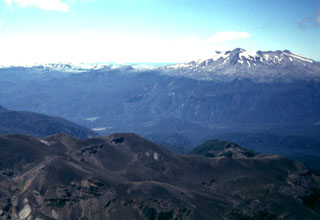Report on Puyehue-Cordon Caulle (Chile) — May 1994
Bulletin of the Global Volcanism Network, vol. 19, no. 5 (May 1994)
Managing Editor: Richard Wunderman.
Puyehue-Cordon Caulle (Chile) Small to moderate earthquakes; emergency plans established
Please cite this report as:
Global Volcanism Program, 1994. Report on Puyehue-Cordon Caulle (Chile) (Wunderman, R., ed.). Bulletin of the Global Volcanism Network, 19:5. Smithsonian Institution. https://doi.org/10.5479/si.GVP.BGVN199405-357150
Puyehue-Cordon Caulle
Chile
40.59°S, 72.117°W; summit elev. 2236 m
All times are local (unless otherwise noted)
Cordón Caulle began generating a series of small to moderate felt earthquakes and discontinuous subterranean noises during the final week of May. The Univ of Chile and the Univ of the Frontera monitored the activity with two seismometers on 28 and 29 May. They detected harmonic tremor and small earthquakes centered N of Puyehue, generally located on Cordón Caulle. Santiago radio reported that four tremors were felt in the area over a 12-hour period on the night of 29 May. The tremors shook with Mercalli-scale intensity IV and V.
The radio report said that the activity had also drawn a team of professionals from the Geosciences Institute of Valdivia Austral Univ to the area. Meanwhile, the police, army officers, civil authorities, and scientists had formed an emergency action committee and established a "White Alert," which signifies the detection of possibly abnormal volcanic activity and mandates that emergency plans be reviewed and updated.
Geological Summary. The Puyehue-Cordón Caulle volcanic complex (PCCVC) is a large NW-SE-trending late-Pleistocene to Holocene basaltic-to-rhyolitic transverse volcanic chain SE of Lago Ranco. The 1799-m-high Pleistocene Cordillera Nevada caldera lies at the NW end, separated from Puyehue stratovolcano at the SE end by the Cordón Caulle fissure complex. The Pleistocene Mencheca volcano with Holocene flank cones lies NE of Puyehue. The basaltic-to-rhyolitic Puyehue volcano is the most geochemically diverse of the PCCVC. The flat-topped, 2236-m-high volcano was constructed above a 5-km-wide caldera and is capped by a 2.4-km-wide Holocene summit caldera. Lava flows and domes of mostly rhyolitic composition are found on the E flank. Historical eruptions originally attributed to Puyehue, including major eruptions in 1921-22 and 1960, are now known to be from the Cordón Caulle rift zone. The Cordón Caulle geothermal area, occupying a 6 x 13 km wide volcano-tectonic depression, is the largest active geothermal area of the southern Andes volcanic zone.
Information Contacts: N. Banks, US Embassy, Santiago.

